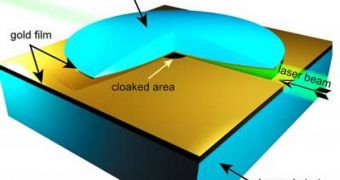Despite the fact that numerous research teams around the globe are currently working to develop the best possible cloaking technology, the methods that exist at this point are very hard to achieve, cost a lot of money to operate, and are also unable to hide larger objects from view. But a breakthrough, achieved by experts at the Purdue University, shows that it's possible to create high-performance cloaking devices, which can absorb all the wavelengths of the visible spectrum, and which can also better cover larger objects than any other at this point.
The PU Robert and Anne Burnett Professor of Electrical and Computer Engineering Vladimir Shalaev explains that the university's new method is so much cheaper and easier to come by than any other in the world today for a very simple reason – it does not rely on metamaterials (which have to be created through complex nanotechnological processes). Instead, the new class of cloaking devices relies on a principle known as tapered optical waveguide, which is employed in already existing technologies, such as fiber optics Internet, TV and phone cables.
“All previous attempts at optical cloaking have involved very complicated nanofabrication of metamaterials containing many elements, which makes it very difficult to cloak large objects. Here, we showed that if a waveguide is tapered properly it acts like a sophisticated nanostructured material,” the expert said. Using their new method, the PU team managed to cloak an object about 100 times larger than the wavelength of the laser used to do it, an achievement never before done anywhere else in the world until now. Details of the accomplishment will be published in the May 29th issue of the scientific journal Physical Review Letters.
The basic design of the cloaking device is very simple, the researchers say. It's created of only two layers of material, both of which are coated in gold. One is shaped like a mirror, while the other is a simple, flat surface. An object about 50 microns in diameter, or about the width of a human hair, was cloaked in the middle of the device, between the two layers. “Instead of being reflected as normally would happen, the light flows around the object and shows up on the other side, like water flowing around a stone,” Shalaev added.

 14 DAY TRIAL //
14 DAY TRIAL //